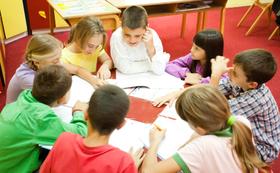For the 2025-26 school year, there are 3 public schools serving 777 students in Mabton School District. This district's average testing ranking is 1/10, which is in the bottom 50% of public schools in Washington.
Public Schools in Mabton School District have an average math proficiency score of 16% (versus the Washington public school average of 41%), and reading proficiency score of 22% (versus the 53% statewide average).
Minority enrollment is 99% of the student body (majority Hispanic), which is more than the Washington public school average of 52% (majority Hispanic).
Overview
This School District
This State (WA)
# Schools
3 Schools
2,563 Schools
# Students
777 Students
1,102,093 Students
# Teachers
45 Teachers
62,276 Teachers
Student-Teacher Ratio
17:1
17:1
Student By Grade
District Rank
Mabton School District, which is ranked within the bottom 50% of all 306 school districts in Washington (based off of combined math and reading proficiency testing data) for the 2022-2023 school year.
The school district's graduation rate of 85-89% has increased from 80-89% over five school years.
Overall District Rank
#276 out of 307 school districts
(Bottom 50%)
(Bottom 50%)
Math Test Scores (% Proficient)
25%
41%
Reading/Language Arts Test Scores (% Proficient)
23%
53%
Science Test Scores (% Proficient)
10-14%
49%
Graduation Rate
(21-22)85-89%
84%
Students by Ethnicity:
Diversity Score
0.03
0.69
% American Indian
n/a
1%
% Asian
n/a
9%
% Hispanic
98%
26%
% Black
n/a
5%
% White
2%
48%
% Hawaiian
n/a
2%
% Two or more races
n/a
9%
All Ethnic Groups
District Revenue and Spending
The revenue/student of $17,667 in this school district is less than the state median of $18,796. The school district revenue/student has grown by 7% over four school years.
The school district's spending/student of $19,109 is less than the state median of $19,247. The school district spending/student has grown by 7% over four school years.
Total Revenue
$14 MM
$20,715 MM
Spending
$15 MM
$21,212 MM
Revenue / Student
$17,667
$18,796
Spending / Student
$19,109
$19,247
Best Mabton School District Public Schools (2025-26)
School
(Math and Reading Proficiency)
(Math and Reading Proficiency)
Location
Quick Facts
Rank: #11.
Artz Fox Elementary School
(Math: 25% | Reading: 22%)
Rank:
Rank:
1/
Bottom 50%10
805 Washington Street
Mabton, WA 98935
(509) 894-4941
Mabton, WA 98935
(509) 894-4941
Gr: K-6 | 398 students Student-teacher ratio: 17:1 Minority enrollment: 99%
Rank: #22.
Mabton Jr. Sr. High School
Magnet School
(Math: ≤5% | Reading: 20-24%)
Rank:
Rank:
1/
Bottom 50%10
500 B St.
Mabton, WA 98935
(509) 894-4951
Mabton, WA 98935
(509) 894-4951
Gr: 7-12 | 374 students Student-teacher ratio: 18:1 Minority enrollment: 97%
Rank: n/an/a
Mabton Step Up To College
Alternative School
Magnet School
Magnet School
500 W Main St
Mabton, WA 98935
(509) 894-2148
Mabton, WA 98935
(509) 894-2148
Gr: 9-12 | 5 students
Frequently Asked Questions
How many schools belong to Mabton School District?
Mabton School District manages 3 public schools serving 777 students.
What is the rank of Mabton School District?
Mabton School District is ranked #299 out of 306 school districts in Washington (bottom 50%) based off of combined math and reading proficiency testing data for the 2022-2023 school year.
What is the racial composition of students in Mabton School District?
98% of Mabton School District students are Hispanic, and 2% of students are White.
What is the student/teacher ratio of Mabton School District?
Mabton School District has a student/teacher ratio of 17:1, which is lower than the Washington state average of 18:1.
What is Mabton School District's spending/student ratio?
The school district's spending/student of $19,109 is less than the state median of $19,247. The school district spending/student has grown by 7% over four school years.
Recent Articles

School Vouchers: Updated Pros and Cons (2025 Review)
Comprehensive 2025 analysis of school vouchers, weighing benefits and challenges for families, funding, outcomes, and policy directions.

Benefits and Drawbacks of Homework in 2025
Explore updated 2025 insights on homework鈥檚 benefits, drawbacks, mental health impact, best practices, and policy trends in U.S. public schools.

Charter Schools vs Public Schools 2025: Key Differences & Trends
Explore updated 2025 insights comparing charter schools vs public schools, enrollment, academic outcomes, funding, and real-world examples for families and educators.





